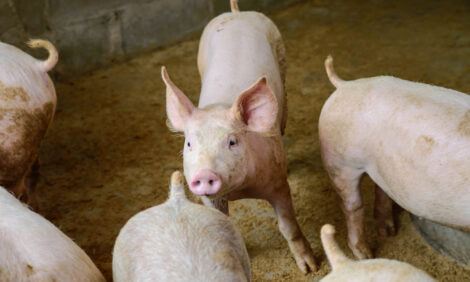



Customer Testimonial: Hypor Maxter
GERMANY - Gerd and Markus Sommer defined their target very clearly: ‘to produce many uniform and robust finishing pigs in line with market requirements with the least input’. They have succeeded in reaching this target, thanks to Hypor and its fast-growing Piétrain.Impact of Hypor Maxter
With consistently increasing feed costs and growing requirements of the slaughterhouses, the breeding development of terminal boars has become more and more important. The focus lies on good feed conversion and high daily gain in combination with low variation and consistency of finishing products.
Hypor was keen to explore the potential of the Hypor Maxter boar line following very positive results in finishing and slaughter characteristics achieved with these boars in other European countries, such as France and The Netherlands.
The first Hypor Maxter boars to be introduced in Germany were acquired by Germany’s biggest AI stud (Genossenschaft zur Förderung der Schweinehaltung, or GFS) and housed at their Artificial Insemination (AI) Stations in Saerbeck and Kiebitzerheide, in Germany, beginning in August 2012.
The market for intact boar production has increased consistently in Germany in recent years and the consequent demand for growth-accelerated boars has increased steadily. This gave Hypor the opportunity to examine Hypor’s Maxter line’s commercial potential in Germany. This required farms that worked with closed systems, offering the opportunity to collect and record reliable data.
The Sommer Family Farm
The 80-hectare, Sommer Family Farm in Cappeln-Elsten in Lower Saxony, Germany was an ideal choice. The Sommer Family first ordered Hypor Maxter semen from Hypor in The Netherlands in 2011. Originally planned as a trial, the results were so convincing that they decided to use Hypor Maxter immediately. Due to availability of Hypor Maxter semen in Germany, the decision was made to switch entirely to Hypor Maxter.
The Sommer Farm has three full-time employees and one trainee, and utilizes some outsourced labor. Its stock operates in a four week rhythm with a 21-day suckling period. No additional animals have been added to the herd since 2006. Remarkably, no piglet milk is used at the farm. The use of terminal boars to produce uniform and vital piglets is, therefore, a crucial component of meeting ever changing market conditions. Table 1 shows the performance data of the sows in 2013 (over 12 months).
| Table 1. Performance data sows 2013 | |
| Sows | 460 |
| Farrowing rate | 92.9% |
| Live born piglets | 13.5 |
| Pre-weaning losses | 11% |
| Weaned per litter | 12.03 |
| Weaned per sow and year | 30.08 |
Starting with Boar Finishing
The decision to start with entire male finishing at the Sommer Family Farm was made in April 2012, so piglet castrations ceased from May 2012 onwards.
Putting the piglets into a younger groups was not possible due to the four weeks production rhythm, so all piglets were introduced into the nursery as one group. A total of 2,200 places were available at two different locations in the nursery (2 × 1,100). As both barns are separated, precise data collection per cycle was possible. The average performance data 2013 is shown in Table 2.
| Table 2: Performance data nursery 2013 | |
| Places | 2,200 |
| Start weight | 6.30kg / 13.89lbs |
| End weight | 31.5kg / 69.45lbs |
| Piglet losses | 1.20% |
| Daily gain | 493g / 1.09lbs |
| Feed conversion ratio | 1:1.55 |
Impact of Hypor Maxter
The Sommer Family stated that they observed a significant ‘impact upon using Hypor Maxter for the first time ever. They had never raised piglets registering daily gains of more than 500g or 1.10 lbs (rearing stable) at a 21-day suckling period before. Furthermore, the superior uniformity of the piglets became obvious very early. The piglets were penned in groups for the finishing phase. No piglets received separate treatment. A low loss rate of 1.2 per cent demonstrated superior management and provided an excellent basis for the finishing period.
Since the middle of 2013, 5,000 places are available at the farm for the finishing phase, so that all piglets can be finished. Previously, some groups of female piglets have been sold. Almost all (90 per cent) of the finishing pigs are finished using liquid feeding machines.
Since October 2013, two control groups per batch were weighed. The feed consumption of both groups is now recorded daily through Hypor’s online facilities. The feed conversion and daily gain could be easily followed during the finishing phase by separate gender. Table 3 shows the average performance data of 9,000 finishing pigs in 2013.
| Table 3: Performance data: Finishing of sows and boars 2013 | |
| Places | 5,000 |
| Start weight | 31.50kg / 69.45 lbs |
| End weight | 119.7kg / 263.89 lbs |
| Finishing losses | 2.3% |
| Daily gain | 907g / 2.0 lbs |
| Feed conversion ratio | 1:2.6 |
“A daily gain of 900g and an excellent feed conversion - superb results!!” said Gerd Sommer. He emphasised that he did not cut back on feed cost per kg and that the feed must have an excellent amino acid content.
The slaughter pigs from the Sommer Family Farm are marketed via the Erzeugergemeinschaft für Qualitätsvieh (Oldenburger Münsterland) – a local producers' organisation for quality livestock - which delivered the finishing pigs mainly to slaughter houses in Emstek and Böseler Goldschmaus in Germany. A monthly overview of the slaughter performance data is shown in Table 4.
| Table 4. Slaughter results 2013 | |||||||
| Month | No. of pigs | Carcass weight | Meat belly % | Belly (lbs) | Ham (lbs) | Loin (lbs) | Shoulder (lbs) |
|---|---|---|---|---|---|---|---|
| Total | 9,288 | 94 | 57.8 | 29.8 | 39.7 | 15.7 | 19.6 |
| Jan. 14 | 213 | 94 | 57.8 | 29.8 | 40.3 | 15.9 | 19.6 |
| Dec. 13 | 996 | 93.9 | 57.4 | 29.8 | 39.9 | 15.7 | 19.4 |
| Nov.13 | 279 | 93.3 | 57.3 | 29.8 | 39.7 | 15.7 | 19.4 |
| Oct. 13 | 426 | 93.8 | 57.6 | 29.8 | 39.7 | 15.7 | 19.6 |
| Sep. 13 | 996 | 95.1 | 56.9 | 30.4 | 40.1 | 15.7 | 19.6 |
| Aug.13 | 1,076 | 93.9 | 57.2 | 30.2 | 40.1 | 15.9 | 19.4 |
| Jul. 13 | 597 | 95.1 | 56.3 | 30.6 | 39.5 | 15.4 | 19.6 |
| Jun. 13 | 596 | 94.2 | 57.2 | 30 | 39.5 | 15.4 | 19.6 |
| May 13 | 961 | 93.3 | 58.8 | 29.3 | 39.2 | 15.4 | 19.6 |
| Apr. 13 | 764 | 95.1 | 58.7 | 29.8 | 40.3 | 15.9 | 20.1 |
| Mar. 13 | 704 | 94 | 57.9 | 29.8 | 39.5 | 15.4 | 19.6 |
| Feb. 13 | 587 | 91.8 | 58.3 | 29.1 | 38.4 | 14.8 | 19.2 |
| Jan. 13 | 1,093 | 94.1 | 59.1 | 29.5 | 39.7 | 15.4 | 19.8 |
Summary
It can be concluded that Gerd and Markus Sommer have achieved their target ‘To produce many uniform and robust finishing pigs in line with market requirements with the least input’. As they are continually looking for improvement, they decided to implement an offspring control test of the Hypor Maxter boars together with GFS.
That the results achieved at the Sommer Family farm are not a coincidence can be seen in a study published by the Chamber of Agriculture of Lower Saxony and Saxony-Anhalt (Landwirtschaftskammer Niedersachsen and Sachsen-Anhalt).
You can read the complete test report in German or download the translated document, or download only the test results in Metrics and Imperial.








